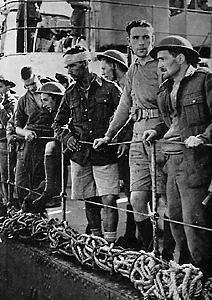Crete, Battle of, was fought between Nazi Germany and Allied forces during World War II (1939-1945). The battle lasted from May 20 to June 1, 1941, and ended in a German victory. Crete is the largest Greek island. It lies in the Mediterranean Sea , about 60 miles (97 kilometers) south of mainland Greece . The German assault on Crete was the first large-scale airborne invasion in history. Crete’s Allied defenders included soldiers from Australia , Greece, New Zealand , and the United Kingdom .
Background.
In late 1940, Greek troops drove back an invasion from Italy . At that time, Italy and Nazi Germany belonged to an alliance known as the Axis Powers . Early in 1941, Allied troops reinforced the Greeks. In April, a large German force helped Italy renew the invasion. By the end of the month, Axis forces controlled the Greek mainland. About 40,000 Allied troops withdrew to Crete, which had been occupied by British forces since November 1940.
The German air force, known as the Luftwaffe , repeatedly raided Crete. Most British Royal Air Force (RAF) warplanes, badly outnumbered, were evacuated to Egypt . British Major General Bernard Freyberg commanded the Crete defense force, called Creforce. Aware of a coming invasion, Freyberg gathered his troops to defend Crete’s northern coast.
Germany’s plan, called Operation Mercury, was to shock the defenders with more than 15,000 airborne troops followed by another 7,000 troops landed by sea. Key to the plan was the capture of Crete’s airfields—particularly Maleme airfield on the western part of the island. The Germans had fewer troops than the defending Allies, but they had a great advantage in air power.

The battle.
On the morning of May 20, 1941, German paratroopers and glider -borne infantry descended on Maleme and nearby Suda Bay. The Germans suffered heavy casualties (people killed and wounded) but still secured areas west of Maleme.
In the afternoon, German paratroopers dropped near airfields at Rethimnon and Iraklion, farther east. Allied defenders again inflicted heavy casualties on the attackers. Close to defeat, the Germans focused their attention on Maleme airfield, which they needed for landing reinforcements and supplies.
At night, a communication failure led Allied forces to abandon key defenses around Maleme. German forces then swiftly took the airfield. By the afternoon of May 21, German planes were landing troops and supplies at Maleme. The following day, a Māori Battalion from New Zealand led a valiant but unsuccessful effort to retake the airfield.
At sea, British Royal Navy warships intercepted the German invasion force north of Crete. The British sank a number of transports carrying German troops. The remaining transports quit the assault and returned to the Greek island of Milos . German warplanes, however, sank several British warships, and the Royal Navy withdrew.
Over the next several days, German troops poured into Maleme. They drove the Allied defenders south in a series of bloody battles. The Allies, under constant air and ground attack and low on supplies, began evacuating troops on May 28. The Royal Navy removed more than 16,000 troops to Egypt, but thousands of other Allied soldiers were left behind. The last of the remaining troops surrendered on June 1.

Aftermath.
About 3,500 Allied troops were killed, and thousands more wounded, during the Battle of Crete. More than 1,800 of the Allied deaths were sailors. About 4,000 Germans died in the fighting, and another 2,600 were wounded. German warplanes damaged or sank a number of Royal Navy ships. Some 12,000 Allied soldiers became prisoners of war .
In areas undefended by the Allies, civilians on Crete resisted the German invaders. In return, the Germans executed many civilians. Thousands of Cretans died during the battle and the German occupation that followed. Crete was not liberated until 1945.
